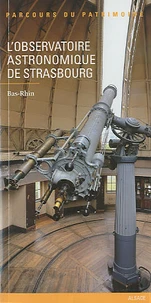The Besançon Observatory. Keeping time by the stars
Par : , ,Formats :
- Paiement en ligne :
- Livraison à domicile ou en point Mondial Relay indisponible
- Retrait Click and Collect en magasin gratuit
- Réservation en ligne avec paiement en magasin :
- Indisponible pour réserver et payer en magasin
- Nombre de pages72
- PrésentationBroché
- Poids0.21 kg
- Dimensions11,4 cm × 22,6 cm × 0,7 cm
- ISBN978-2-36219-052-0
- EAN9782362190520
- Date de parution01/04/2012
- CollectionParcours du Patrimoine
- ÉditeurLieux Dits
Résumé
Responding to demands of the clock and watch makers of Besançon and of the Besançon local authorities, a presidential decree of 11 March 1878 created at Besançon a new ‘astronomical, meteorological and chronometrical observatory’. Chronometry was at the origins of this new establishment and explains its originality. The clock and watch-making capital of France now had a tool to control its products and improve their qualities.
One hundred and thirty years later, the departmental centre of the French weather-forecasting services for the Doubs and the Besançon observatory are still pursuing their original aims.
The establishment today has a staff of about forty people, involved in astrophysics and time-frequency studies. At the request of local manufacturers, it has recently re-instated the certification of time pieces. This publication offers a history of the observatory and a glimpse of its rich architectural and instrumental heritage.
The establishment today has a staff of about forty people, involved in astrophysics and time-frequency studies. At the request of local manufacturers, it has recently re-instated the certification of time pieces. This publication offers a history of the observatory and a glimpse of its rich architectural and instrumental heritage.
Responding to demands of the clock and watch makers of Besançon and of the Besançon local authorities, a presidential decree of 11 March 1878 created at Besançon a new ‘astronomical, meteorological and chronometrical observatory’. Chronometry was at the origins of this new establishment and explains its originality. The clock and watch-making capital of France now had a tool to control its products and improve their qualities.
One hundred and thirty years later, the departmental centre of the French weather-forecasting services for the Doubs and the Besançon observatory are still pursuing their original aims.
The establishment today has a staff of about forty people, involved in astrophysics and time-frequency studies. At the request of local manufacturers, it has recently re-instated the certification of time pieces. This publication offers a history of the observatory and a glimpse of its rich architectural and instrumental heritage.
The establishment today has a staff of about forty people, involved in astrophysics and time-frequency studies. At the request of local manufacturers, it has recently re-instated the certification of time pieces. This publication offers a history of the observatory and a glimpse of its rich architectural and instrumental heritage.


